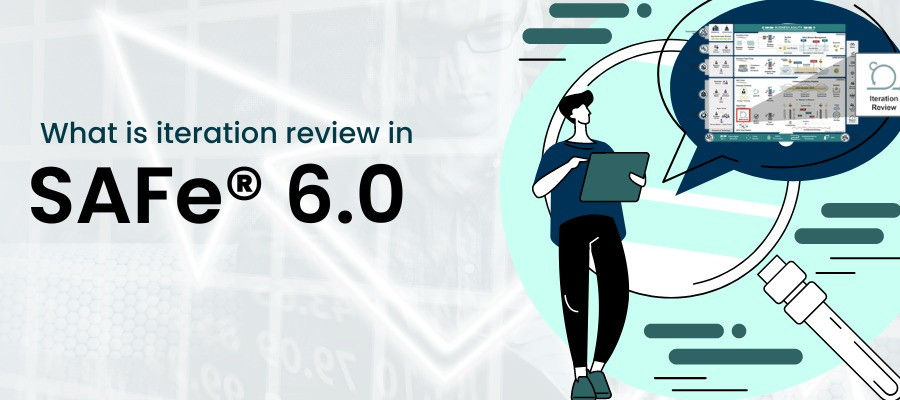What is iteration review in SAFe® 6.0?

In the world of SAFe® 6.0, iteration review holds a pivotal role in the Agile development process. This cadence-based event is a platform for teams to assess their progress at the end of each iteration and make necessary adjustments to their backlog for the next phase.
Agile Teams embark on a journey of measuring and showcasing their achievements during the iteration review. They present working stories, demonstrating the tangible progress they have made, to the Product Owner and other stakeholders. This provides an opportunity to gather valuable feedback and insights. Let’s understand the interaction review in SAFe® 6.0 in depth.
What Makes the Iteration Review Essential?
The iteration review plays a pivotal role in the Agile development process. It offers a valuable platform for teams to regularly gather immediate and contextual feedback from their stakeholders. This critical event serves multiple purposes, aiming to measure progress and foster continuous improvement.
- Closure and Value Generation:
By closing the iteration timebox, the iteration review recognizes the collective efforts of numerous individuals who have contributed to delivering new value to the business. It serves as a moment of reflection, acknowledging the completion of work and its tangible impact.
- Showcasing Contributions and Cultivating Pride:
During the iteration review, team members have the opportunity to showcase the unique contributions they have made to the project. This demonstration moment allows them to take pride in their work and acknowledge their individual and collective achievements. It serves as a reminder of their value to the team and the larger organizational goals.
- Feedback for Improvement:
An integral aspect of the iteration review is soliciting feedback from stakeholders. This feedback acts as a catalyst for improvement, providing valuable insights that can help refine the solution under development. By actively seeking feedback, teams can iterate and enhance their work, ensuring that it aligns more closely with the needs and expectations of their stakeholders.
Iteration Review Journey: Reflections, Demos, and Continuous Improvement
The iteration review initiates with a comprehensive examination of the Iteration Goals, engaging in discussions about their current status. Subsequently, it progresses into a walkthrough of all the committed stories. A working and thoroughly tested system is showcased to demonstrate completed stories effectively, preferably in a staging environment that closely resembles the production environment. Additionally, any spikes conducted are presented through findings and insights.
A crucial aspect of the iteration review lies in gathering feedback from stakeholders, which serves as the primary objective of this review process. Stakeholders can provide valuable insights and comments on the stories that are demonstrated. Their feedback is a guiding light for the team, directing them toward refining and enhancing their work.
Following the demo, the team reflects, considering incomplete stories and investigating the reasons behind their unfinished state. This discussion often uncovers impediments or risks, such as false assumptions, shifting priorities, estimation inaccuracies, or over-commitment.
Collaborative Engagement of Key Participants
The iteration review brings together a range of participants, each playing a vital role in the process. Attendees at the iteration review typically include:
Agile Team: This encompasses the Product Owner, who represents the stakeholder's interests and guides the team in delivering value, and the Scrum Master, who facilitates the Agile development process. The Agile Team actively participates in the review, showcasing their progress and seeking stakeholder feedback.
Stakeholders: Individuals or groups interested in the team's progress and the product being developed attend the iteration review. These stakeholders may include representatives from other teams, customers, end-users, or business sponsors. Their presence ensures transparency and fosters collaboration among stakeholders involved in the project.
It's important to note that while Agile Release Train (ART) stakeholders have the option to attend the iteration review, their interests and level of detail usually align more closely with the System Demo. The System Demo provides a broader view of the product's functionality and integration across multiple teams within the ART.
Guidelines for a Successful Iteration Review
Optimal Preparation: Encourage team members to limit their preparation time to approximately one to two hours. This helps maintain a balance between thorough preparation and efficient use of time.
Timeboxing: Timebox the iteration review event to around one to two hours. This promotes focus and ensures that the review stays within the designated timeframe.
Emphasize Working Software: Minimize the use of slides during the iteration review. Instead, prioritize showcasing and gathering feedback on working software functionality, hardware components, or tangible deliverables.
Validate Definition of Done (DoD): Ensure completed stories meet the Definition of Done (DoD) criteria before the review. This validation guarantees that the work presented meets the necessary quality standards.
Wrapping up
The iteration review in SAFe® 6.0 is a critical event in the Agile development process. It provides a platform for Agile Teams to assess their progress, gather stakeholder feedback, and make necessary adjustments for continuous improvement. The iteration review serves multiple purposes, including closing the iteration timebox, showcasing individual and collective achievements, and soliciting feedback for refinement.
By following guidelines for a successful iteration review, teams can ensure adequate preparation, timeboxing, working software emphasis, and the Definition of Done criteria validation.
Reference
- https://v5.scaledagileframework.com/iteration-review/
- https://scaledagileframework.com/iteration-review/



